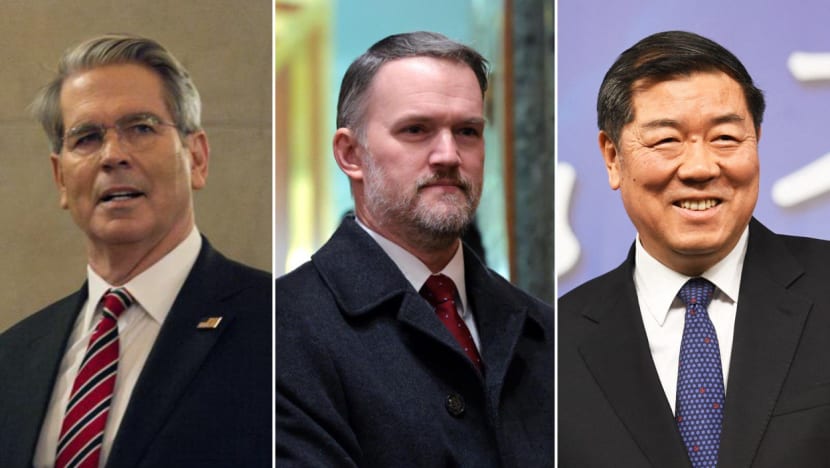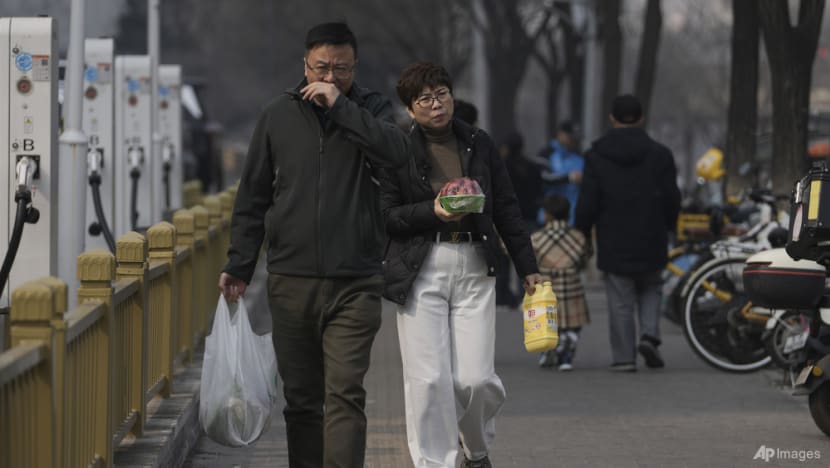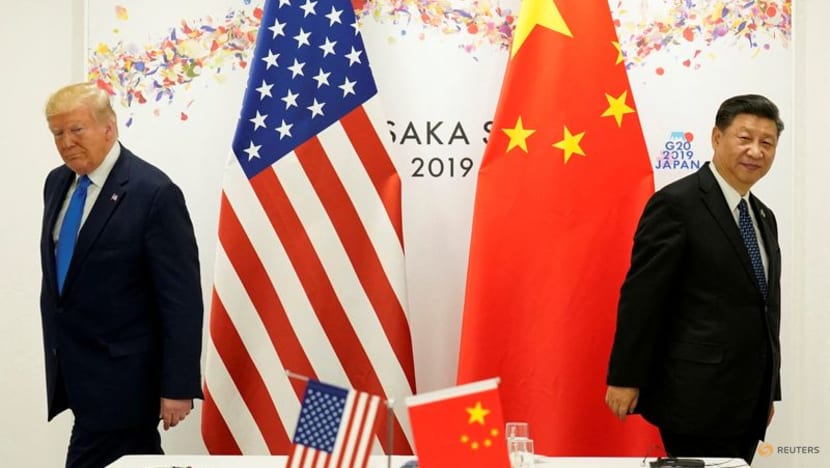analysis East Asia
‘Tolerance for pain is higher in China’: Beijing enters US tariff talks with upper hand
US and Chinese officials meet in Switzerland this weekend for talks over the tariff war between them. Analysts say expectations are low and symbolism outweighs substance.

US Treasury Secretary Scott Bessent (left), US Trade Representative Jamieson Greer (center), and Chinese Vice Premier He Lifeng (right) are set to meet in Switzerland this weekend as the US and China start first face-to-face trade talks amid rising economic tensions. (Photo: AFP)

This audio is generated by an AI tool.
SINGAPORE: From Washington and Beijing, planes carrying senior leaders and trade officials are en route to one negotiating table in Switzerland - but who has the upper hand?
The imbalance in negotiating power is already clear, analysts said, as US and Chinese officials convene in Switzerland this weekend for their first face-to-face trade talks since President Donald Trump’s sweeping new tariffs took effect.
The meetings, scheduled for Saturday (May 10) and Sunday, will be led by US Treasury Secretary Scott Bessent and Trade Representative Jamieson Greer. On Beijing’s side, Vice Premier He Lifeng will represent the government.
Despite its own domestic economic strain, China enters the talks with firmer demands, a unified message, and greater strategic patience, according to observers. The United States, by contrast, has tempered expectations and downplayed the prospects of a deal.
“China does have the upper hand because the US is reaching out,” said Wang Dan, China director at Eurasia Group.
“The trigger for (the talks) is mainly the domestic condition of the US. People have anticipated some hardships, but nobody expected this type of turbulence in the market.”
To be sure, both China and the US are “feeling real economic pain from these outlandishly high tariffs”, said Dexter Tiff Roberts, a nonresident senior fellow at the Atlantic Council’s Global China Hub.
The US faces the threat of empty store shelves and higher consumer prices, while China grapples with a loss of export-related jobs.
“I do think, though, that the tolerance for pain is higher in China … the whole ability to ‘eat bitterness’,” said Roberts, referring to the Chinese saying “chi ku”, which means to “eat bitterness” or to endure hardship.

A HARDER LINE FROM BEIJING
The US has made clear that the talks are not expected to yield a breakthrough, with Bessent describing them as a first step toward outlining topics for future negotiations.
“My sense is that this will be about de-escalation, not about the big trade deal,” Bessent said in an interview with Fox News on Tuesday. “We’ve got to de-escalate before we can move forward.”
Beijing, meanwhile, has taken a markedly different tone.
China’s commerce ministry issued a statement ahead of the talks insisting the US “must face up to the serious negative impact of unilateral tariff measures on itself and the world.”
It warned that China “will never agree” to any outcome based on “coercion and blackmail”.
The message from Beijing has been consistent: without significant tariff relief, there will be no substantive negotiation.
“I don’t think it’s a tactic,” said Wang. “It’s essentially a safe play for Beijing, because Trump is unpredictable. Even if something is agreed privately … there still can be changes when it comes to the official talks.”
“So China is very much aware of that, and (President) Xi wants to control the situation.”
Roberts noted that Chinese officials had previously denied US claims that negotiations were underway.
“Trump and his people repeatedly said talks were happening when apparently they were not,” he said. “I think they thought saying that would be a strategy to make talks happen sooner.”
“The US is the one that comes into this feeling a little more desperate … I think there was a misperception that China would somehow be more of a pushover and more desperate to come to the talks. And I don't think that's what's happened.”
Xu Jianwei, senior economist for Greater China at Natixis, noted that any US move to reduce tariffs would carry political risk.
“Rolling back tariffs too much would inevitably invite an uncomfortable question for the US: what was the point of the confrontation if it led us back to square one?” he said.
POLICY DIVERGENCE, ECONOMIC STRAIN
The talks come amid growing economic strain in both countries.
Trump’s tariff package imposed a 10 per cent blanket duty on virtually all imports, on top of existing 25 per cent tariffs on steel, aluminium, automobiles, and parts. Since January, he has also raised tariffs on Chinese imports to 145 per cent, prompting Beijing to hit back with 125 per cent on US exports.
In China, up to 16 million export-related jobs could be at risk under the current US tariffs, according to estimates by Goldman Sachs analysts. These include factory workers whose jobs have been jeopardised by stalled operations and cancelled orders.
In the US, many businesses have warned of disrupted supply chains and looming shortages.
In fact, CEOs of major retailers - including Walmart and Target - have reportedly told the White House that inventories are shrinking and price increases are imminent.
Even Trump has acknowledged that “at some point” the tariffs may need to come down. “Otherwise you could never do business with them,” he told NBC’s Meet the Press last week.
Against this backdrop, the UK and US announced a “breakthrough deal” to reduce some tariffs - the Trump administration’s first bilateral deal since the tariff onslaught.
Markets responded enthusiastically: on Thursday, the S&P 500 rose 0.6 per cent, the Dow gained 0.6 per cent and the Nasdaq climbed 1.1 per cent.
On Friday, Trump signalled that he could lower tariffs on Chinese imports, writing in a post on his Truth Social platform that "80% Tariff on China seems right!"
Trump previously hinted that tariffs on China could be lowered if the Switzerland talks made progress.
“We’re going to see. Right now you can't get any higher. It's at 145 per cent so we know it's coming down,” Trump said.
According to analysts, recent stock market volatility and mixed inflation signals are increasing pressure on Washington to ease tensions - while Beijing watches closely.
“China wants to see what the US can offer,” said Roberts.
Wang added that the consequences are playing out differently in each country.
“There’s more of the economic cost to China,” she said. “For the US, it’s a more political cost.”
“(The) Chinese people and Chinese businesses are used to this kind of policy uncertainty … I think the pain might - on the surface - be more visible for US consumers, but for China, it's real welfare loss.”
Meanwhile, China’s central bank on Wednesday cut the required reserve ratio by 0.5 percentage points and trimmed the seven-day reverse repo rate by 0.1 percentage points - moves aimed at increasing liquidity while keeping broader policy restrained.
According to Wang, these adjustments are not signs of panic.
“It’s not in a hurry to come out with aggressive rate cuts or monetary easing,” Wang said.
“All those messages coming out from (the central bank announcements) are in line with a long term goal. It’s still (about) the technology upgrade, building up the capital market to serve the real economy.”

Roberts said the policy shift was timed to strengthen Beijing’s negotiating posture.
“This was clearly preparation for trade talks. They're trying to put a little support under a weak economy, and that does give them ultimately more leverage to walk away. They're not gonna be pushovers. There's no way.”
China’s leaders have insisted that they remain confident of hitting this year’s GDP growth target.
On May 5, during a meeting of financial officials in Milan, Finance Minister Lan Fo’an reiterated that “China will adopt more proactive and robust macroeconomic policies and is confident of achieving the growth target of ‘around 5 per cent’ for 2025”.
Yet the government has so far resisted a major stimulus, focusing instead on long-term goals like tech self-sufficiency and financial system reform.
“These are relatively minor adjustments,” said Daryl Guppy, an Australian financial columnist and CEO of Guppytraders.com, “although it suits Western observers to interpret them as something significant because this allows the US to claim their tariff attack has worked”.
“THEY’VE BEEN PREPARING FOR THIS”
Beijing’s leverage in the talks stems from years of preparation, analysts said.
China has shifted to reduce reliance on the US market, cultivating deeper ties with the Global South and investing in infrastructure through the Belt and Road Initiative.
“The US is far more dependent on China across its supply chain,” said Guppy.
“China has replacement markets … The US is increasingly vulnerable because it cannot quickly substitute China imports.”
Guppy argued that Trump’s team is operating on outdated assumptions.
“They are thinking of China pre-COVID,” he said.
“(They) do not understand the tremendous economic restructure with the digital economy that has taken place since then.”
Roberts noted that China has not been idle in preparing for worsening ties with Washington.
“China hasn’t been static, they’ve been preparing for this.”
“They already dealt with Trump 1.0, and they already had a trade war on a much smaller level with Trump in the first round,” he added.
China's exports rose faster than expected in April, growing 8.1 per cent year-on-year, according to customs data released on Friday. However, China's exports to the US fell 17.6 per cent compared to the previous month.
According to the US commerce department on May 6, imports from China were the lowest in five years and could drop further, given reports of a massive decline in cargo from China.
In the first quarter of 2025, ASEAN overtook the US as China’s largest trading partner, with bilateral trade reaching $234.2 billion - 16.6 per cent of China’s overall foreign trade - a 7.1 percent year-on-year rise.
WHAT’S ON THE TABLE?
Analysts said the mere fact that talks are happening marks a “breakthrough”. Whether that leads to meaningful progress depends on what the US is willing to offer - and how Beijing responds.
Roberts said a tariff reduction remains likely - a necessary first step before further negotiations can begin.
“Obviously, the first thing they can do is reduce the tariffs, and that's what they'll do. We'll see the tariffs come down. That's the first part of any deal.”
“It might not happen on Saturday, but I think it's likely that we're gonna see that happen soon,” he added.
Wang is more sceptical. “I think we all have very low expectations,” she said.
“No concrete results are expected from this meeting … if there are no real concessions from the US then this talk is nothing.”
China wants the US to remove the tariffs, said Wang. “Otherwise, it's a lack of sincerity from China's point of view.”
Symbolic progress could take the form of extended dialogue or modest tariff rollbacks.
Roberts noted that even small adjustments may allow both governments to save face.
“China might be like we haven't gotten far enough, but we're moving in the right direction,” he said. “Trump could say … ‘Can you believe how they caved?’”

Wang said more technical wins are possible.
“If somehow the US is able to offer some concrete measures, then maybe we're looking at some small deals that involve a currency or export quota … it can be a win on both sides,” she said.
Taiwan could even surface in the talks as part of a broader negotiation, if Washington offers deeper concessions.
“China really wants the US to potentially to somehow reframe their commitment to Taiwan, to give Beijing more power, more leverage over Taiwan,” said Roberts. “I think there's a possibility that the Trump administration could do that as well.”
According to analysts, truly substantive outcomes - such as easing tech export restrictions, formal mechanisms to stabilise the yuan, or commitments on intellectual property - are far less likely in the near term.
“Over the long term, the direction of US-China decoupling is clear,” said Natixis’ Xu.
“But both China and the US will carefully weigh the economic costs before taking each step forward. Without real progress in trade negotiations, both sides will suffer: China will lose export-related jobs, while the US will face higher consumer prices.”
While both sides face serious economic constraints, analysts said China appears in no rush to arrange a meeting between President Xi Jinping and President Trump.
“It’s the last thing China wants to do, to put Xi Jinping in a humiliating position,” said Wang, referencing Trump’s meeting with Ukrainian President Volodymyr Zelenskyy that ended in a shouting match.
“They would rather endure trade war for much longer.”
“I think the US is more supplicant now than China,” Roberts said. “And China has the leverage, but no one's gonna admit to that in Washington.”
Guppy contrasted the two leaders’ negotiating styles: “The Art of the Deal is no match for Sun Tzu’s The Art of War.”




















